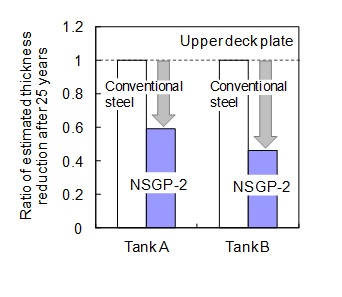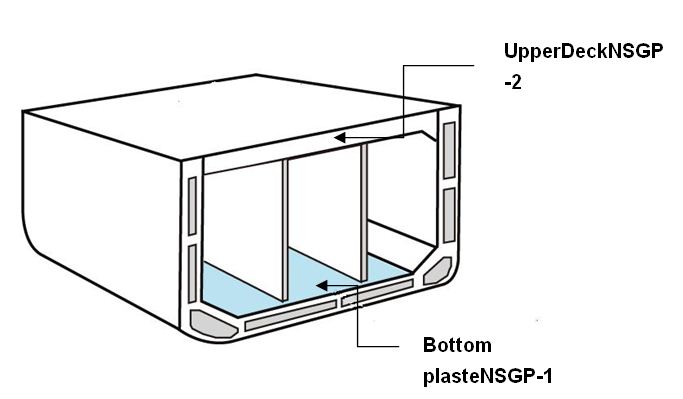NSGP(TM)-2, Highly Corrosion resistant Steel Plate for Crude Oil Tankers, Obtains World First Marine Type Approval for the deck plate in Tanks
Nov. 06, 2014
Nippon Steel & Sumitomo Metal Corporation
NSGPTM-2, Highly Corrosion resistant Steel Plate
for Crude Oil Tankers, Obtains
World First Marine Type Approval
for the deck plate in Tanks
NSGP-2(*1), highly corrosion resistant steel plates for crude oil tankers developed by Nippon Steel & Sumitomo Metal Corporation (NSSMC; Representative Director and President - Mr. Kosei Shindo), were approved for the first time in the World by Nippon Kaiji Kyokai (ClassNK) in September and Lloyd's Register Group in October as materials that meet the corrosion resistant standards for upper decks (ceiling parts) of crude oil tanker’s cargo oil tanks(COT) prescribed by the International Maritime Organization (IMO).
Owing to the amendment of the SOLAS Convention(*2) related to corrosion prevention measures for the cargo tanks of crude oil tankers in 2010, it has become compulsory to adopt corrosion protection methods for tankers subject to construction contracts from 2013 onward. When using corrosion resistant steel as a corrosion protection measures, it has become necessary to obtain approval that the steel satisfies rules of IMO and other relevant requirement for ship material from authorized public organizations such as classification soceities . As NSSMC’s NSGP-2 has received approval from Class NK and Lloyd's Register Group, it has become possible to use the product commercially without painting when applying it to the COT of crude oil tankers that are obliged to prevent corrosion.
NSGP-2 corrosion resistant steel plates for crude oil tankers have alomost same usage performance as conventional steel such as welding and processing while maintaining corrosion resistance through the optimal combination of a small amount of alloying elemetns in order to prevent corrosion of the deck plates of the COT of crude oil tankers, which entail the risk of leading to serious accidents such as oil leakage.
As a result of applying NSGP-2 to an actual ship(*3) and verifying the corrosion prevention effects over a long period of time, it was estimated for the first time in the world that the plate thickness of steel plates was able to be reduced to roughly 50-60% compared to conventional steel when using the product for 25 years.
NSSMC had already obtained approval for NSGP-1 steel plates for the bottom plates of COT from ClassNK in 2011. By using NSGP-1 in combination with NSGP-2, which obtained approval on this occasion, painting both the bottom and the ceiling of COT has become unnecessary. Moreover, at the time of construction and when carrying out regular maintenance after completion, painting costs will be reduced and work periods will be shortened, including peripheral preparations such as scaffolding for painting and inspection, while environmental load will also be mitigated.
NSSMC will continue efforts to contribute to the greater safety of ships and the global environment through the development and supply of high-performance steel.,
*1: NSGP stands for Nippon Steel and Sumitomo Metal Green Protect.
*2: An international convention adopted by the MSC87 (Maritime Safety Committee) of the IMO (International Maritime Organization) in May 2010. It requires corrosion prevention methods based on painting that conforms to painting performance standards or alternative measures such as the use of corrosion resistant steel for COT used in crude oil tankers of 5,000 DWT or more.
*3: NSGP-2 was applied on a trial basis to a crude oil tanker that went into commission in August 2005.
Figure 1 shows the application sites of NSGP-2 and Figure 2 shows the performance of corrosion resistance (assuming use of 25 years).

Figure 1: Application sites of corrosion resistant steel

Figure 2: Ratio of estimated plate thickness reduction after 25 years
in use in actual ship trial (upper deck plate)
in use in actual ship trial (upper deck plate)

Figure3: Application area of NSGP in cross secton of VLCC


